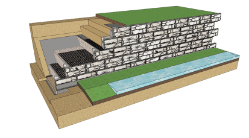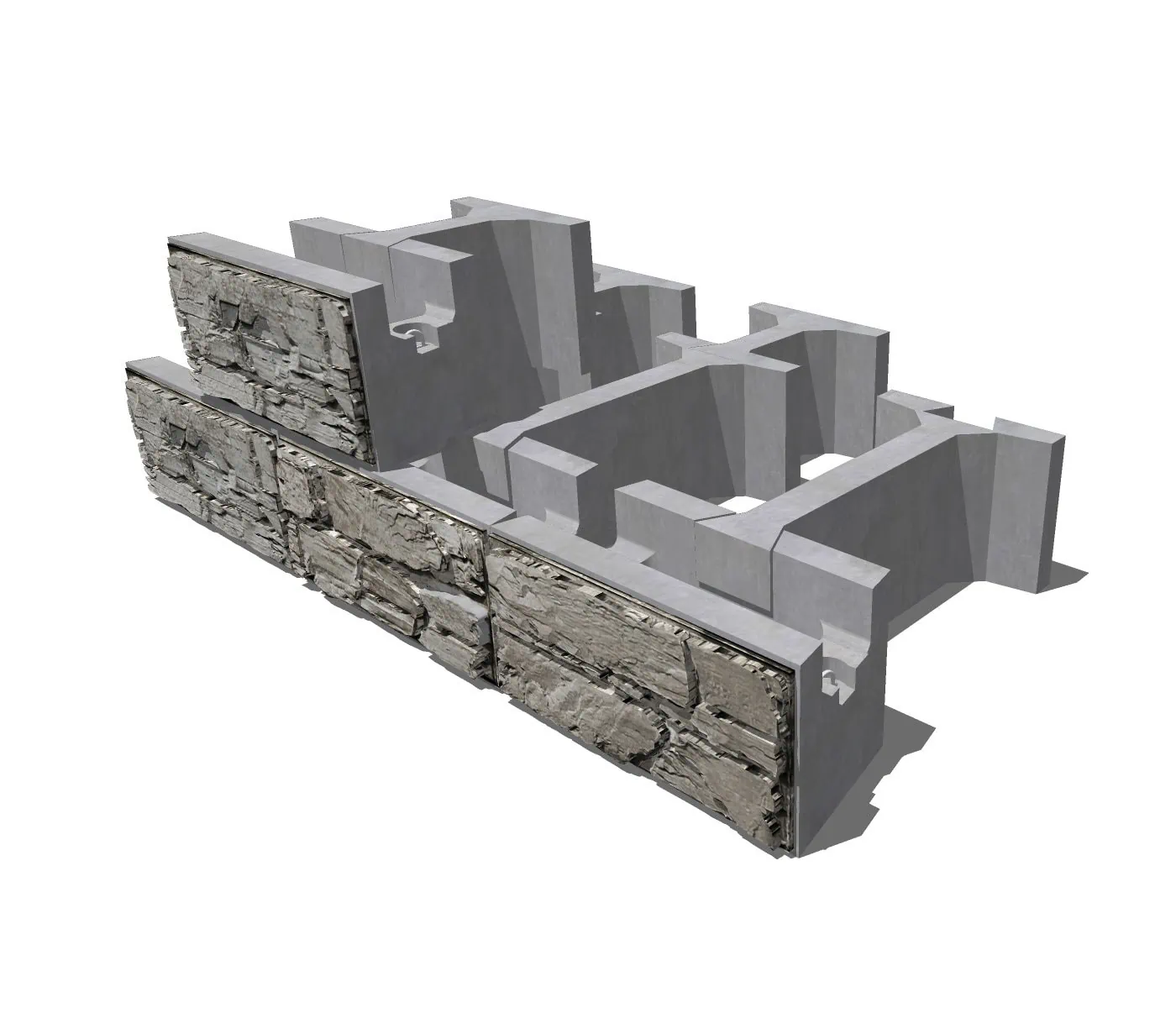Retaining Wall
Stormwater &
Erosion
Management
Systems

MagnumStone’s Role in Stormwater Infiltration
MagnumStone retaining walls are a trusted leader in stormwater management that protect the properties of homeowners, businesses and governments worldwide. Through the global increase of infrastructure and new developments, stormwater management is now considered a vital engineering design requirement.
Flooding, land erosion and scouring have become more common due to larger impermeable surfaces in community neighbourhoods and urban centres. These impermeable surfaces include (but are not limited to) city roads, sidewalks, parking lots and structures like houses and buildings. Rather than the ground naturally absorbing the rainfall, these surfaces act as an umbrella which inhibits proper drainage and stormwater removal across major urban developments.
Like they have for decades, MagnumStone retaining walls continue to play a prominent role in stormwater management. These powerful retaining wall water applications range from eco-friendly bioretention ponds to permanent stormwater drainage channels with reinforced stream banks.
Temporary (Detention) Stormwater Management
Solutions
Dry Ponds, Detention Basins, Detention Ponds

Permanent (Retention) Stormwater Management Solutions
Wet Ponds, Retention Basins & Retention Ponds

Stormwater Conveyance, Drainage Channels & Stream Banks
Stream banks, Storm Drains, Street Gutter and Piping Systems, Inlets to Catch Basins

Bioretention Stormwater Management
Solutions
Bioretention Basins, Rain Gardens

How do Stormwater Management Systems Work?


Stormwater management systems are advanced drainage systems that help collect and remove or convey rainfall and surface water runoff. Most commonly these systems utilize stormwater control measures and remove water from impermeable surfaces including paved parking lots or roadways after heavy rainfall storms.
The four most prominent forms of stormwater infrastructure include:
-
Temporary (Detention) Stormwater Management
-
Permanent (Retention) Stormwater Management
-
Stormwater Conveyance, Drainage Channels & Stream Banks
-
Bioretention Stormwater Management
Some stormwater management systems simply capture and remove water from an area which is susceptible to water damage. More sophisticated drainage systems contain built-in water treatment capabilities to filter and treat the water and surface runoff. These calculated designs can efficiently remove pollutants, sediments and contaminants from the water via all-natural structured processes below the surface.
Stormwater Conveyance
Interactive 3D Model
Load times may very depending on internet speed.
How Our Hollow Core is Designed for Exceptional Drainage
Before runoff enters drainage networks – namely detention, retention, conveyance or bioretention systems – several stormwater control measures help manage the process. Redirecting water toward the stormwater infrastructure is the first step. This is accomplished by guiding water along a graded surface toward swales, drainpipes or retaining walls along its outer perimeter that promote effective drainage and minimize unwanted pooling of water.
Retaining walls with proper drainage foster a safe, even spread of water along the toe of the wall. Slowing and controlling water flow below the wall is critical and will avoid overwhelming its next destination. This can be achieved by including a short, graded grass slope or adding riprap below the retaining wall. These techniques help disperse and slow down high velocity surface runoff during storm surges.
How MagnumStone Blocks Provide Protection
From roads and parking lots to tight urban areas and expansive properties, MagnumStone has you covered. Our retaining walls perform and excel in the toughest scenarios including coastal waterfronts and withstanding tropical storms.

learn more about how we can help you utilize the
MagnumStone advantage!
Types of MagnumStone
Stormwater Solutions
Temporary (Detention) Stormwater Management
A natural processing area to temporarily collect, hold, filter and slowly release stormwater runoff. MagnumStone retaining walls help direct water to the dry pond area below or at the toe of the wall. This is accomplished thanks to the MagnumStone hollow core block design which allows for optimal drainage, horizontally and vertically.
Temporary stormwater management systems include dry ponds and detention basins. They are often found in the form of multi-use recreation areas that are typically dry, along parks and vegetated street ditches.

Permanent (Retention) Stormwater Management
A natural processing area to temporarily collect, hold, filter and slowly release stormwater runoff. MagnumStone retaining walls help direct water to the dry pond area below or at the toe of the wall. This is accomplished thanks to the MagnumStone hollow core block design which allows for optimal drainage, horizontally and vertically.
Temporary stormwater management systems include dry ponds and detention basins. They are often found in the form of multi-use recreation areas that are typically dry, along parks and vegetated street ditches.

Stormwater Conveyance, Drainage Channels & Stream Banks
Conveyance systems are a series of natural or manufactured drainage features that guide and funnel stormwater runoff downstream to receiving waters such as rivers or streams. Similarly, a stormwater channel is a long, narrow and permanently excavated waterway designed to convey surface runoff.
Conveyance and drainage channels are built to endure intermittent stormwater surges, fed by piping systems and street gutters. These canal-shaped waterways are graded and lined with retaining walls so that stormwater runoff is strategically slowed by riprap or weirs along the bottom. Riprap is also used to prevent scouring or undermining of the base blocks along the structure’s walls, which could erode and wash away the base leveling pad.

Bioretention Stormwater Management
Conveyance systems are a series of natural or manufactured drainage features that guide and funnel stormwater runoff downstream to receiving waters such as rivers or streams. Similarly, a stormwater channel is a long, narrow and permanently excavated waterway designed to convey surface runoff.
Natural, sustainable ways of treating and removing stormwater runoff have become an effective approach for new developments and infrastructure. Commonly referred to as bioretention ponds, bioretention basins or rain gardens.
Bioretention areas are dedicated drainage areas landscaped and engineered to ensure proper filtration of sediments and

Temporary (Detention)
Stormwater ManagementA natural processing area to temporarily collect, hold, filter and slowly release stormwater runoff. MagnumStone retaining walls help direct water to the dry pond area below or at the toe of the wall. This is accomplished thanks to the MagnumStone hollow core block design which allows for optimal drainage, horizontally and vertically.
Temporary stormwater management systems include dry ponds and detention basins. They are often found in the form of multi-use recreation areas that are typically dry, along parks and vegetated street ditches.

Permanent (Retention) Stormwater Management
Engineered control structures that collect and treat large volumes of water runoff. These generally contain an outlet for excessive water overflow after severe rainfall events to prevent flooding.
For these true water applications, MagnumStone retaining walls permanently hold runoff delivered through drainage systems. These systems typically have water in them at all times, similar to artificial lakes or canals.
Permanent stormwater management systems include wet ponds, retention basins, and retention ponds.

Stormwater Conveyance, Drainage Channels & Stream Banks
Conveyance systems are a series of natural or manufactured drainage features that guide and funnel stormwater runoff downstream to receiving waters such as rivers or streams. Similarly, a stormwater channel is a long, narrow and permanently excavated waterway designed to convey surface runoff.
Conveyance and drainage channels are built to endure intermittent stormwater surges, fed by piping systems and street gutters. These canal-shaped waterways are graded and lined with retaining walls so that stormwater runoff is strategically slowed by riprap or weirs along the bottom. Riprap is also used to prevent scouring or undermining of the base blocks along the structure’s walls, which could erode and wash away the base leveling pad.

Bioretention Stormwater Management
Natural, sustainable ways of treating and removing stormwater runoff have become an effective approach for new developments and infrastructure. Commonly referred to as bioretention ponds, bioretention basins, or rain gardens.
Bioretention areas are dedicated drainage areas landscaped and engineered to ensure proper filtration of sediments and to promote habitat for wildlife. They help control, treat, and remove water through evapotranspiration and gradual permeation into the land or underdrains below. The engineered soil layers of Bioretention ponds allow for optimal filtration and are mostly dry areas that capture stormwater runoff.















